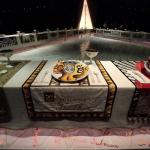An Actual Dinner Party Inspired by Judy Chicago’s “The Dinner Party”

A delicious thought experiment: If you could host any four women from history to your private dinner party, whom would you invite? More important, what would you serve? Victoria Flexner, the twenty-nine-year-old founder of Edible History, a New York-based supper-club-cum-test-kitchen dedicated to bringing “the past to life and on the plate,” took such pleasure in contemplating the question while admiring Judy Chicago’s iconic feminist installation “The Dinner Party”—in which thirty-nine place settings, representing thirty-nine women from Western civilization, are seated around a triangular table—at the Brooklyn Museum, that she decided to throw her own dinner party.
Along with her executive chef, Jay Reifel, the pair picked four women out of the thirty- nine originally featured in Chicago’s work and concocted a meal showcasing items from each of the periods in which the women lived. The trickiest part proved to be finding recipes from the relevant eras. “We would have loved to have the Primordial Goddess,” Reifel said, “but it’s anyone’s guess what she ate.”
On a muggy July evening, forty guests gathered at the Museum of Food and Drink, in Brooklyn, and took their seats at three long tables that made up an equilateral triangle, just like in Chicago’s piece. Under each plate was a small piece of laminated paper bearing the name of one of Chicago’s thirty-nine women. “There was an extra person at the last minute,” Flexner whispered to a guest, “so we added Judy Chicago as an attendee.”
First up: an appetizer of oysters drizzled with cumin, lovage, and pepper, from the days of Sappho, the poet of ancient Greece immortalized for her lines celebrating love and desire between women. The recipe had been culled from Apicius, a nameless collection of Roman recipes thought to have been compiled in the first century and which Reifel said was likely written entirely by men.
At one table, several diners were trying oysters for the first time. The woman sitting at the Georgia O’Keeffe place setting, an art administrator celebrating her twenty-second birthday, gleefully downed hers in one mouthful and pronounced the texture “silky” and “delightfully greaseless.”The woman in Mary Wollstonecraft’s place, a palliative-care nurse in her sixties, expressed trepidation about the experience, and poked at the shell with the prongs of a fork. “Just do it already, for pity’s sake,” her companion, sitting in Sacajawea’s place, prodded impatiently. The nurse turned to her friend with a scowl. “I’m doing it for womankind, so let me take my time.”
The second course, inspired by Christine de Pisan, the Venice-born late-medieval author best known for defending the rights of women, was stuffed capon wrapped in parma ham and served with a bright-orange sauce of verjus and saffron. “What was capon, anyway?” someone asked. “An emasculated rooster,” Reifel replied. (In fact, he used chicken, which is more readily available.) There was quiet murmuring and the clinking of cutlery as guests dug in. “Isn’t it strange that the only people who eat capons are sixteenth-century courtiers and twenty-first-century Brooklyn hipsters?” a publisher in his thirties, at the Susan B. Anthony setting, observed as he chewed. “What would you know?” a food writer in the Emily Dickinson spot retorted. “You were foraging for food on your suffragette tours, and were probably lucky to eat potatoes, or weevils.” After a beat, she added, “Though, to be fair, it’s not like I was faring much better. I was in Amherst, depressed and sad and not eating very much of anything, probably, except for a nightcap.”
The standout dish of the night was courtesy of Eleanor of Aquitaine, the Queen Consort of France and later England, and appropriately named the Helmeted Cock. A whole roasted suckling pig, splayed on all fours, was wheeled out; a bird, painted in edible silver, was riding the pig, with a gilded-paper lance in one tightly gripped claw, as if out to battle.
A grad student in world history who had the spot of Hildegarde of Bingen, a German nun and philosopher (“I had to Google her,” he confessed), studied the heap of meat in front of him, which was served with a vinegary burnt-bread sauce. “It’s almost like molecular gastronomy,” he observed, looking a bit overwhelmed. “I wonder if the chef was kinda the Heston Blumenthal of his age?” His friend across the table, whose place card read Petronilla de Meath, the victim of a fourteenth-century Irish witch hunt, smirked and shook his head in mock disapproval. “Dude, we are at a feminist dinner, and all it makes you think of is some white guy?”
In a little while, the dessert arrived, inspired by Sojourner Truth and the Christian martyr St. Agatha of Sicily, whose breasts were cut off after rejecting the sexual advances of a Roman official. All the pastries arrived in the shape of small hemispheres, dotted in the center with a brightly colored frosting nipple. Reifel introduced one of the baked goods, an aliter dulcia, as a “nut custard.” “Nut custard,” Petronilla repeated, stifling giggles as he used his spoon to jiggle the dessert boob. His fiancée, seated at the Eleanor of Aquitaine place setting, shook her head with queenly impassivity. “Jesus,” she said. “I can’t believe I’m marrying you.”
